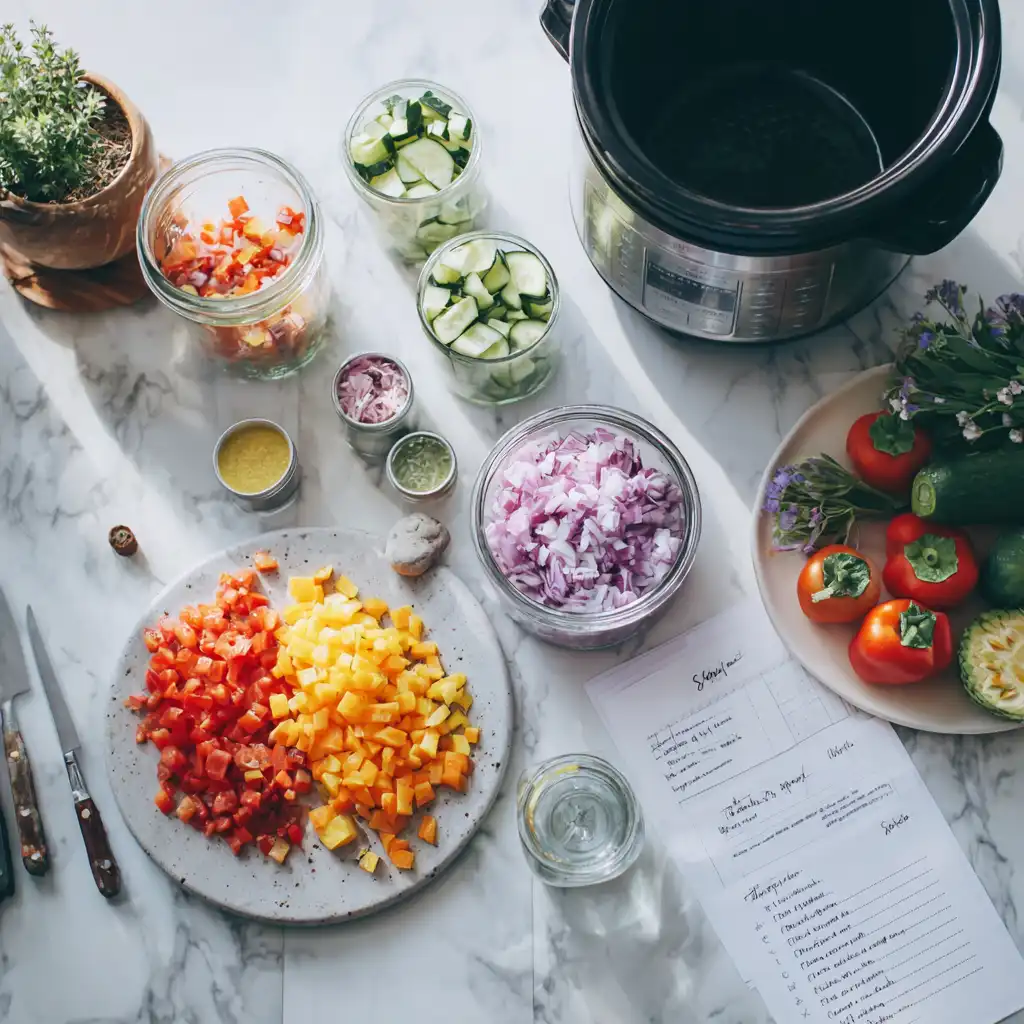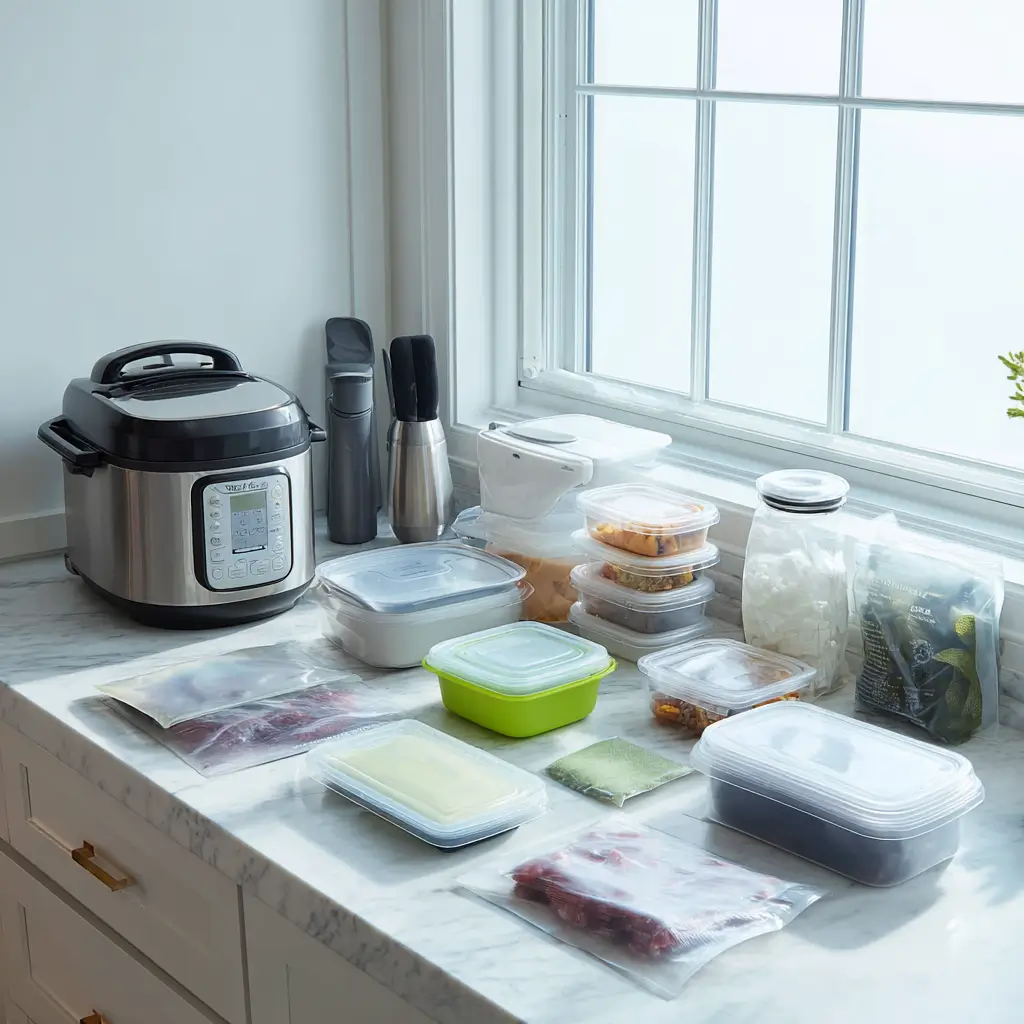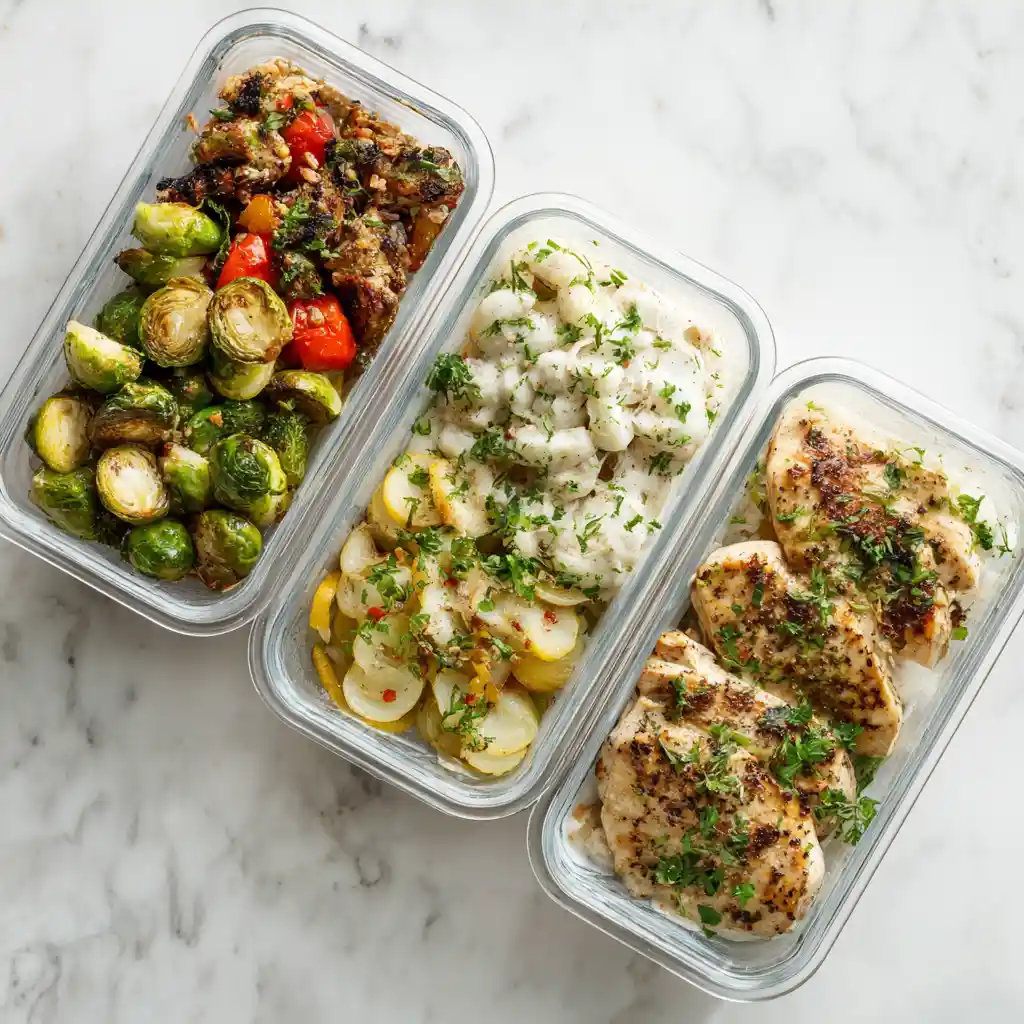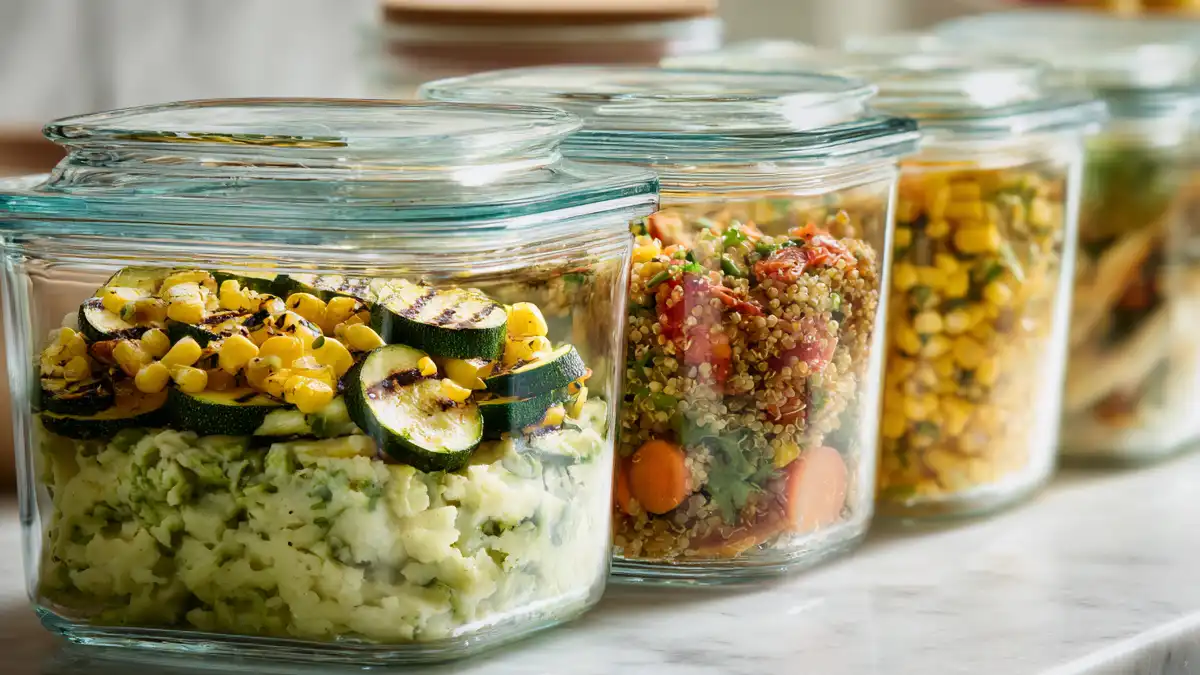Table of Contents
Summer’s long days and blazing heat are no time to be stuck over a stove every day. That’s where batch cooking & freezer-friendly summer recipes come to the rescue. Whether you’re juggling a busy schedule, trying to beat the heat, or simply looking to simplify mealtime, batch cooking can save you serious time, energy, and stress.
This guide covers everything from smart planning strategies to delicious meal ideas that freeze beautifully—plus safe freezing tips, summer-specific meal plans, and tools that make your kitchen routine cooler and cleaner.
Let’s start with why batch cooking just makes more sense when it’s hot out.
Why Batch Cooking Makes Sense in Summer
Reduce kitchen time and heat exposure
Nobody wants to turn up the oven at 5 PM in July. Batch cooking allows you to spend just a few hours cooking one or two times a week, drastically cutting down daily stove or oven use. Cooking multiple meals at once—especially during cooler early mornings—keeps your kitchen cooler and your home more comfortable. Plus, prepping in bulk lets you avoid standing over hot pots and pans every evening.
Make mealtime effortless on hot days
Once meals are prepped and frozen, summer evenings become way easier. You just need to thaw, reheat, and eat. This is especially handy after long pool days, travel, or even busy work weeks. By batch cooking, you eliminate the guesswork from dinner, reduce decision fatigue, and skip the stress of last-minute cooking.
Avoid daily cleanup and grocery trips
With batch cooking, you prep once and clean once. That means fewer dirty pans, cutting boards, and bowls piling up throughout the week. It also lets you shop smarter—buying ingredients in bulk, cutting down on waste, and avoiding multiple sweaty grocery runs.
Planning Your Summer Batch Cooking Sessions
Batch cooking in summer requires a slightly different approach than in cooler months. You want to minimize heat, maximize efficiency, and build meals around fresh, seasonal ingredients. With just a bit of forethought, your prep day can run like clockwork—and leave you with a freezer full of ready-to-eat meals that won’t heat up the house.

Choose the right day and time to prep
Hot afternoons aren’t ideal for cooking. The best time to batch cook in summer is early in the morning or later in the evening when temperatures are cooler. Pick a day when your schedule is relaxed—Sundays work well for many families—and set aside 2–3 hours to get everything done without rushing. This also ensures you’re not stuck in the kitchen during the warmest part of the day.
Group meals by ingredients and cook time
Efficiency is key when batch cooking. Start by choosing recipes that share overlapping ingredients like summer squash, tomatoes, or grilled chicken. This cuts down on chopping time and helps you use everything you buy. Also, group meals by cook time—for instance, roast all vegetables at once, or prepare stove-top dishes back-to-back to avoid reheating the kitchen multiple times.
Creating a meal matrix or a prep list can help you visually organize your plan. Here’s a simple example:
| Group | Recipes | Shared Ingredients |
|---|---|---|
| Oven | Roasted veggie wraps, Sheet pan chicken | Bell peppers, zucchini, onions |
| Stove | Pasta primavera, Black bean chili | Garlic, tomatoes, beans |
| No-Cook | Chickpea salad, Tuna wraps | Canned tuna, cucumbers, herbs |
Use a slow cooker to double up batches
Slow cookers are underrated in the summer. While ovens can heat up your kitchen fast, a slow cooker stays cool and does the work for you—often producing two meals at once. Try cooking shredded chicken, pulled pork, or lentils in big batches and portioning them for wraps, grain bowls, or salads throughout the week.
You can also set it and forget it—prep early, then let your slow cooker run while you relax or get errands done. For added convenience, use slow cooker liners to speed up cleanup time.
Freezer-Friendly Meal Types for Summer
Choosing the right kinds of meals is the secret to batch cooking success—especially in summer. You want dishes that are not only freezer-friendly but also light, refreshing, and heat up without becoming mushy or soggy. The best meals balance protein, seasonal veggies, and complex carbs in a way that stays tasty straight from the freezer.
Soups and stews with seasonal vegetables
You might not think of soup as a summer food, but chilled soups like gazpacho or light veggie broths with zucchini, corn, or tomatoes are summer staples. And let’s not forget heartier freezer options like lentil stew, chicken chili, or corn chowder—perfect for cool evenings or when served with a crisp salad.
To freeze, cool completely, portion into freezer-safe containers, and leave room at the top for expansion. For quick meals, freeze in single-serving pouches you can grab and go.
Chicken, beef, or veggie-based mains
Protein-forward meals are batch cooking MVPs. Think:
- Grilled chicken with summer squash
- Taco-spiced ground beef
- Veggie lentil loaf or bean patties
These hold up well to freezing and can be repurposed easily. For example, frozen pulled chicken can be used in wraps, salads, or rice bowls. Tip: Let meats rest and cool completely before freezing to retain moisture and texture.
When reheating, using a covered skillet or microwave with a splash of broth can help revive frozen proteins without drying them out.
Grain bowls, wraps, and ready-to-heat sides
Cooked grains like quinoa, brown rice, and couscous freeze beautifully. Batch-cook them, then mix and match with protein and veggies to make grain bowls or wraps later in the week.
Pre-assembled wraps (with dry fillings only) can be wrapped tightly in foil and frozen, ready to be tossed in the toaster oven. For sides, consider roasting sweet potatoes, sautéing green beans, or prepping grilled corn—freeze in portions, then reheat when needed.
Tools That Help with Batch Cooking
Having the right tools can take your batch cooking routine from overwhelming to effortless. Whether you’re storing meals for a week or a month, investing in a few freezer-friendly essentials will help preserve freshness, prevent spills, and keep your kitchen organized. These tools also ensure your hard work doesn’t go to waste due to freezer burn or poor labeling.

Storage containers (glass, BPA-free, stackable)
When freezing summer meals, the container makes all the difference. Glass containers are ideal for both freezing and reheating—they’re durable, non-toxic, and microwave-safe. BPA-free plastic containers are a lighter alternative and work well for short-term storage.
Choose containers that stack easily to maximize freezer space. Portion-sized containers also make grabbing a lunch or dinner super convenient.
Top tip: Avoid round containers. Square or rectangular ones optimize freezer space and reduce air pockets that cause freezer burn.
Slow cooker liners for quick reus
If you’re using your slow cooker to prep meals in batches (which is smart for summer), liners are a game-changer. They make cleanup a breeze and let you prep multiple meals back-to-back without scrubbing between uses. These liners are heat-resistant and food-safe, and they also reduce oil absorption for lighter, cleaner meals.
Slow cooker meals that freeze well include shredded BBQ chicken, black bean stew, and tomato-based sauces—all easy to transfer and store thanks to liners.
Labels, freezer bags, and vacuum sealers
Labeling your meals is non-negotiable. Use waterproof labels and a permanent marker to jot down:
- Meal name
- Date prepared
- Reheat instructions (optional)
Freezer bags are perfect for soups, stews, or anything you can lay flat to freeze. Stack them like books in the freezer for easy access. For longer-term storage, vacuum sealers prevent freezer burn by removing air and sealing in freshness.
Here’s a quick tool checklist:
| Tool | Use | Summer Advantage |
|---|---|---|
| Glass containers | Reheat & store | Microwave & dishwasher safe |
| Vacuum sealer | Long-term freezing | Prevents air exposure & burn |
| Freezer bags | Stackable soups/sides | Saves space & easy to label |
| Slow cooker liners | Multiple meals/day | Keeps kitchen cool & clean |
Safe Freezing & Thawing Techniques
Freezing your meals properly is just as important as cooking them. Poor freezing methods can lead to mushy textures, lost flavor, or worse—food safety risks. In summer, it’s especially important to handle your food quickly and correctly to avoid spoilage and bacteria growth.
Follow these simple but crucial steps for safe freezing and thawing.
Portioning meals before freezing
Don’t just toss an entire casserole dish into the freezer and hope for the best. Portion meals in single servings or family-size portions based on your household’s eating habits. This not only saves space but makes it easier to defrost exactly what you need—without wasting anything.
Try using meal-sized glass containers for full dinners, or small BPA-free containers for lunch portions. Label each with a date and meal name so you’re never left guessing.
Pro tip: If you’re freezing something with sauce (like pasta or chili), freeze it in a muffin tin first, then transfer those “meal pods” into a bag for easy reheating.
Avoiding freezer burn and leaks
Freezer burn is caused by air exposure and results in dry, tough, or rubbery food. To prevent this:
- Use airtight containers or vacuum seal bags
- Leave minimal air space when sealing
- Let food cool completely before freezing
For soups and stews, always leave about an inch of space in your container to allow for expansion during freezing. Seal bags tightly and lay them flat while freezing so they can be stacked vertically later.
Also, double-bag liquids or saucy items to avoid leaks and messes in your freezer.
Thawing safely in summer heat
Thawing your meals safely is crucial in hot months. Never leave frozen food on the counter—especially during summer when temperatures climb quickly. Instead:
- Thaw in the refrigerator overnight
- Use a microwave’s defrost setting for faster options
- For soups or sauces, reheat directly from frozen in a pot or pan
Avoid thawing in warm water or outdoors. This leads to bacteria growth and food safety risks. When in doubt, go slow and cool with your thawing process.
Here’s a quick reference table:
| Food Type | Best Thawing Method | Summer Safety Tip |
|---|---|---|
| Cooked proteins | Refrigerator overnight | Never thaw on counter |
| Soups/stews | Direct to stovetop or microwave | Stir occasionally for even heat |
| Grains/veggies | Microwave defrost or fridge | Don’t leave out longer than 2 hours |
With your meals prepped and stored the right way, you’re almost ready to build a batch cooking menu. In the next part, I’ll walk you through three complete batch cooking plans tailored for hot weather.
3 Sample Batch Cooking Plans for Hot Weather
Summer calls for meals that are light, flavorful, and easy to prep in bulk. Whether you’re vegetarian, feeding a protein-hungry household, or need mix-and-match options for picky eaters, these three freezer-friendly meal plans have you covered.

All three plans are built around:
- Efficient prep times (2–3 hours total)
- Overlapping ingredients
- Easy freezing and fast reheating methods
Let’s break them down.
Light Vegetarian Plan
Perfect for: Meatless households, light summer meals, lunch preppers
This plan focuses on plant-based proteins, cool flavors, and meals that won’t feel heavy in hot weather.
Meals to Prep:
- Roasted Veggie Grain Bowls (with quinoa, zucchini, bell pepper)
- Black Bean Burritos (wraps stored individually in foil)
- Summer Corn Chowder (light, coconut milk-based, frozen in pouches)
- Mediterranean Chickpea Salad (store ingredients separately, assemble before serving)
Tips:
- Avoid freezing greens like spinach or arugula; add fresh when serving
- Chill roasted veggies before freezing to preserve texture
- Use citrus-based dressings on the side
High-Protein Family Dinners
Perfect for: Larger households, growing kids, active adults
This plan is protein-heavy and built to satisfy with minimal effort after thawing.
Meals to Prep:
- BBQ Pulled Chicken (in slow cooker, portioned for sliders or bowls)
- Beef & Veggie Pasta Bake (frozen in foil pans for oven reheating)
- Chicken Fajita Packs (pre-cooked, ready to reheat in a skillet)
- Hard-Boiled Eggs + Hummus Packs (ready-to-go snacks for busy days)
Tips:
- Use lean meats to prevent grease separation during freezing
- Shred meats before freezing—they thaw and reheat more evenly
- Label fajita packs with “reheat with 1 tbsp water” to retain moisture
Mix-and-Match Combo with Sides & Mains
Perfect for: Busy households needing flexibility, grab-n-go meals
This plan gives you a variety of components you can combine into bowls, wraps, or full dinners.
Prep These Sides:
- Garlic Roasted Sweet Potatoes
- Herbed Couscous
- Grilled Corn-Off-the-Cob
And These Mains:
- Lemon-Dill Salmon Cakes
- Teriyaki Chicken Strips
- Spiced Lentil Patties
Ideas for Assembly:
- Salmon cakes + couscous + greens
- Lentil patties + sweet potato + tahini drizzle
- Chicken strips + corn + brown rice (optional)
Tips:
- Freeze patties on a baking tray before bagging to prevent sticking
- Store sides in separate small containers to keep flavor separation
- Label items clearly so family members can build their own meals
Here’s a sample prep overview:
| Plan | Meals | Approx. Prep Time | Freezer Storage |
|---|---|---|---|
| Vegetarian | 4 meals | 2.5 hrs | 10 containers & 4 wraps |
| High-Protein | 4 meals + snacks | 3 hrs | 12 portions |
| Mix-and-Match | 6 components | 2 hrs | 15+ single meals |
Batch cooking in summer doesn’t mean repeating the same meals—it means creating flexible, delicious options you can pull out at any time.
FAQs About Freezer Meals and Summer Cooking
What types of meals are best for freezing in summer?
The best meals for freezing in summer are light, nutritious, and reheat well without losing texture. Think grilled proteins like chicken or tofu, vegetable-packed soups and stews, grain bowls with quinoa or couscous, and freezer-friendly wraps. These options are satisfying without being heavy, making them ideal for hot weather. Avoid meals with high-water content veggies like lettuce or cucumber, and steer clear of dishes with cream-based sauces, which tend to separate when thawed.
How do I avoid freezer burn on hot days?
Freezer burn occurs when food is exposed to air, causing dehydration and poor texture. In summer, this can happen faster due to frequent freezer door openings. To prevent it, always let food cool completely before freezing, use airtight or vacuum-sealed containers, and remove as much air as possible from bags. Label your meals and organize your freezer to reduce how long the door stays open, which helps maintain consistent cold temperatures.
How should I portion meals before freezing?
Portioning is all about convenience and reducing waste. For best results, divide meals into single-serving or family-sized containers depending on your needs. You can also freeze sauces or soups in muffin tins, then transfer the portions to freezer bags once solid. This method makes it easy to thaw just what you need. Use clear containers or well-labeled bags so you know what’s inside without having to open them.
Is it safe to freeze cooked soup or stew?
Yes, cooked soups and stews are excellent for freezing and one of the most popular options for batch cooking. Just be sure they’re completely cooled before freezing, and avoid adding pasta or cream until you’re ready to reheat. Freeze in shallow containers or bags with extra space to allow for expansion. These meals can be reheated directly from frozen or thawed overnight in the fridge for better texture.
What’s the best way to cool food before freezing?
The safest way to cool food before freezing is to divide it into smaller portions to speed up the process. You can also place containers in an ice water bath or stir warm dishes frequently to release steam faster. Never place hot food directly into the freezer, as this can raise the internal temperature and put other frozen items at risk. Let your meals reach refrigerator temperature before freezing for the best results.
How long can I safely store food in the freezer?
Freezer storage times vary depending on the food type. Cooked meats and casseroles last about 2–3 months, while soups and stews stay fresh for up to 3 months. Cooked grains like rice or quinoa are best used within 1–2 months. Blanched vegetables can last up to 6 months. Always label and date everything, and use a “first in, first out” system to keep your freezer stock rotating efficiently.
What’s the safest way to thaw frozen meals in summer?
During summer, it’s especially important to thaw meals safely. The best option is to place meals in the refrigerator overnight. If you’re short on time, use the microwave’s defrost setting or reheat directly from frozen in a skillet, saucepan, or oven—especially for soups, sauces, and stews. Never thaw meals on the counter, in a hot car, or outdoors, as bacteria can grow quickly at room temperature, especially in summer heat.
Conclusion
When summer heats up, spending hours in the kitchen isn’t ideal. That’s why batch cooking & freezer-friendly summer recipes are a game-changer—letting you prep once and eat well for days. From grain bowls to grilled proteins and light soups, these meals freeze beautifully and make dinner effortless. With smart planning and the right tools, you can keep your kitchen cool and your family well-fed all season long.
Want more ideas like this? Follow us on Facebook and Pinterest for simple, flavorful recipes!
You might also like these recipes
- Slow Cooker Shredded Chicken Tacos Recipe
- Low-FODMAP Slow-Cooker Recipe Beef and Potato Stew
- No Bean Chili Slow Cooker Recipe
- Cheddar and Broccoli Soup Slow Cooker


1 thought on “Batch Cooking & Freezer-Friendly Summer Recipes”